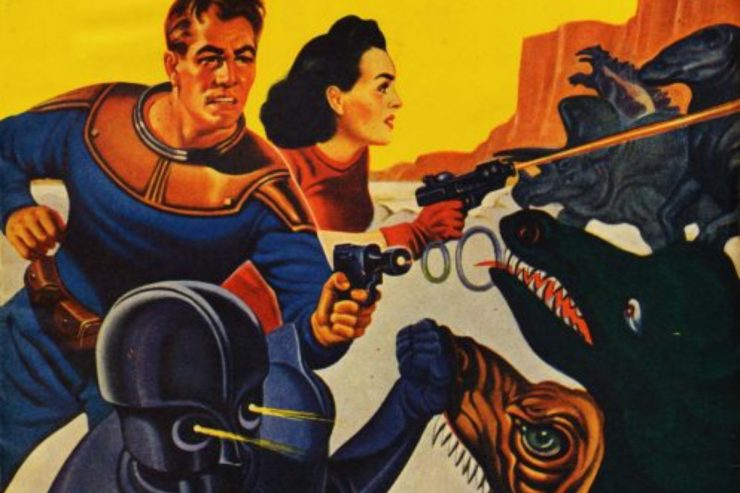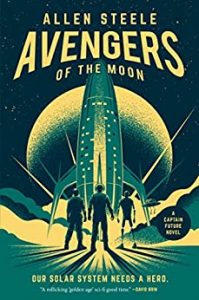
Pulp magazines have influenced writers, artists, film directors, software developers, and countless others over the years. Our “PulpFest Profiles” focus on contemporary creators who have drawn inspiration from these rough-paper fiction magazines.
I’ll admit it, I’m a Captain Future fangirl. When I first heard about Allen Steele’s new Captain Future novel, Avengers of the Moon, I was instantly curious. Who was this fellow writing about my fave “Wizard of Science?” I just had to find out.
In this month’s “PulpFest Profile,” I chat with award-winning science fiction writer, Allen Steele, author of many popular works including the new Captain Future stories.
Sara Light-Waller (SLW) It’s great to chat with you today, Allen. Let’s start with an easy question — when did you first know you wanted to be a writer?
Allen Steele (AS) When I was 14 or 15 I had a hobby of writing short stories for my own entertainment. I also had a knack for telling ghost stories around my Boy Scout troop’s campfire. But I didn’t really know I could be a writer until I attended my first science fiction convention — Kubla Khan — in my hometown of Nashville, Tennessee. That’s where I first met Frederik Pohl. By the end of the weekend, I’d decided that writing was something I could do for the rest of my life. My ambitions have become bigger and better since then but that’s where it all started. Not many people get to grow up and do what they wanted to do when they were kids, so I’m very fortunate.
(SLW) What led you to the field of science fiction in particular?
(AS) Of all the stuff I read when I was a kid, I liked science fiction the most. I turned away from imaginative fiction while at college and wrote a mainstream novel that was never published. (Thank God, because it was awful.) I majored in journalism and became a newspaper reporter for a number of years. I was never really happy with it as a career and kept coming back to SF. While the mainstream novel was making the rounds, I decided my next project would be a science fiction novel. Orbital Decay was published when I was 29. That sale enabled me to leave journalism and launch my SF writing career.
(SLW) You’ve won numerous writing awards, including several Hugo’s. Please tell us about your proudest accomplishments.
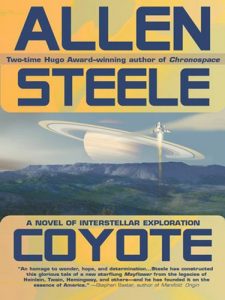 (AS) I’m very proud of my awards, including the Heinlein Award for career achievement. But I believe that writing a really enjoyable story or novel is the highest award for any writer. I know that sounds corny, and if anyone had told me I’d ever feel that way back when I was a rookie writer, I wouldn’t have believed them. But, just last week, I received a letter from one of my readers, a former felon, who’d found my books in the library of the state prison where he’d spent seven years. He wrote that he was out now and had read my Coyote series several times while incarcerated. He told me that the book had helped keep him sane during those difficult years. Coyote and its sequels didn’t receive any awards, they weren’t even nominated, but I’ll take a letter like that over a Hugo or a Nebula any time.
(AS) I’m very proud of my awards, including the Heinlein Award for career achievement. But I believe that writing a really enjoyable story or novel is the highest award for any writer. I know that sounds corny, and if anyone had told me I’d ever feel that way back when I was a rookie writer, I wouldn’t have believed them. But, just last week, I received a letter from one of my readers, a former felon, who’d found my books in the library of the state prison where he’d spent seven years. He wrote that he was out now and had read my Coyote series several times while incarcerated. He told me that the book had helped keep him sane during those difficult years. Coyote and its sequels didn’t receive any awards, they weren’t even nominated, but I’ll take a letter like that over a Hugo or a Nebula any time.
(SLW) Space colonization is an evergreen subject in sci-fi and you’ve written several popular series about it including the three Coyote series. Please share something with us about the Coyote universe.
(AS) Coyote began as a response to the first seasons of Star Trek: The Next Generation. I liked the show well enough but the longer I watched it, the more annoyed I became. I’ve always been a space buff, and I was in the midst of writing my Near Space series at the time. I knew all about the dangers of space exploration and decided to write a novel that took a much more realistic approach to interstellar travel. Coyote turned into a series of five sequential novels and three spinoffs set in the real world. To date, I think it’s my biggest achievement.
(SLW) Do you believe that humans will eventually colonize space?
(AS) I think humankind will eventually colonize space, it’s probably inevitable. We’re presently exploring the solar system via robotic proxy. Before long, I believe we’ll see space tourism turn into space colonization.
(SLW) Writers often project their dreams into their books, and some imagine participating in the grand adventures they write about. Would you want to be aboard one of those early colony ships?
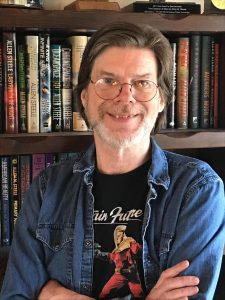 (AS) If you’d asked me that question twenty or thirty years ago, I would’ve unhesitatingly said, “yes.” But I’m now in my 60’s and my health isn’t as good as it was even ten years ago. While I could still make a jaunt into low-orbit on a Blue Origin or SpaceX or Virgin Galactic flight, I’m not hardy pioneer stock anymore. I’ll just have to continue traveling into space and to other worlds the way I always have: in my imagination.
(AS) If you’d asked me that question twenty or thirty years ago, I would’ve unhesitatingly said, “yes.” But I’m now in my 60’s and my health isn’t as good as it was even ten years ago. While I could still make a jaunt into low-orbit on a Blue Origin or SpaceX or Virgin Galactic flight, I’m not hardy pioneer stock anymore. I’ll just have to continue traveling into space and to other worlds the way I always have: in my imagination.
(SLW) Of all your published books and stories, which are your top three favorites and why?
(AS) This is the question most writers hate because it’s the equivalent of asking a parent which child is their favorite. That said, I believe my recent work is better than my early work, with a few notable exceptions. The novels I’ve been producing over the last five or six years are my best yet. I’m still very proud of the Coyote series, and there’s no question that Coyote is the book I’ll most likely be remembered for. I think my novel, Arkwright — which is a later treatment of the first interstellar colonization mission — is the better novel. I’m also very proud of the Captain Future series. And I honestly think the short fiction which has won Hugos rightly deserved the recognition. I have some books and stories which relatively few people have read that are as good as the more renowned work. My young-adult novel, Apollo’s Outcasts, is one of my very best books. I’m also proud of my first published novel, Orbital Decay, and my first published short story, “Live from the Mars.”
(SLW) You’ve recently published a Captain Future novel — Avengers of the Moon — and four CF novellas — “Captain Future in Love,” “The Guns of Pluto,” “1,500 Light Years From Home,” and “The Horror At Jupiter.” When did you first read the original Captain Future tales?
(AS) I discovered Captain Future when I was 11 years old. The first one I read was a paperback reprint of Outlaws of the Moon, with a great Perry Rhodan cover from 1965. Although the science in the novel was way off, a big deal for me, it was still entertaining as hell. I liked Outlaws of the Moon so much that whenever I spotted another book with the name Captain Future on the cover, I picked it up. I read Planets in Peril, The Magician of Mars, and Captain Future’s Challenge in childhood. I didn’t read any of the others until later because I couldn’t find them. At that time, you might find loads of Luke Short westerns and Mike Shayne mysteries in Nashville, but science fiction was harder to come by.
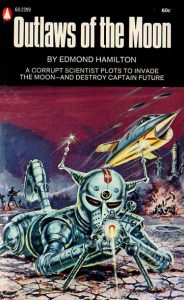 (SLW) What was your inspiration for bringing back Curt Newton and the Futuremen?
(SLW) What was your inspiration for bringing back Curt Newton and the Futuremen?
(AS) About 15 years ago, I was having frequent pancreatitis attacks and would be rushed to the hospital for two to four days. I was on a lot of pain meds at the time, making it difficult to read complex fiction. It was then that I rediscovered classic pulp heroes — Doc Savage and The Shadow. I also stumbled across an eBook reprint of Captain Future and the Space Emperor. I don’t know how much the morphine had to do with it, but it occurred to me that Hamilton had created an intriguing cast of characters and a well-colonized solar system. I thought it might be possible for a good writer to update and reboot everything, creating a new Captain Future for the 21st century. That thought eventually became my novel, Avengers of the Moon.
(SLW) Captain Future was originally a pulp hero from the late 1930s. You’ve given him something of a modern make-over. Besides making him more approachable to contemporary readers, what other goals did you have for updating Captain Future and his friends?
(AS) After Avengers of the Moon, I decided to use my new Captain Future series to take a grand tour of the solar system. I wanted to show humankind as a true spacefaring civilization, inhabiting even the hostile worlds of the solar system. The alien races living on these planets and moons are bioengineered offshoots of Homo sapiens called, Homo cosmos. I’ve renamed Martians as Aresians and Venusians as Aphrodites to get away from the cultural baggage of the old names. I’ve also created an interplanetary political conflict revolving around the long-term effort to terraform Mars and the terrorist resistance movement that Ul Quorn created in response. That was the part I had the most fun with creating and writing.
(SLW) Are you pleased with the way the stories turned out?
(AS) I’m as proud of my Captain Future series as I am with the Coyote series, which had been the high-water mark up until then. I spent the pandemic writing the latter three volumes of the CF series and it really helped ease my frame of mind.
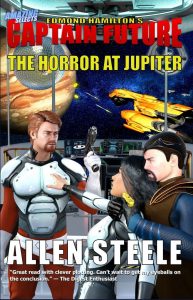 (SLW) Do you have plans for more Captain Future books?
(SLW) Do you have plans for more Captain Future books?
(AS) I would like very much to write another Captain Future series, although it probably won’t be as long or ambitious as The Return of Ui Quorn. Whether I can actually do it depends on how well the series sells, the overall reader response, and whether my friends at Experimenter Publications and Amazing Stories will support such an effort. So we’ll see.
(SLW) Do you consider any of your other books or stories directly pulp-inspired? If so, which ones?
(AS) Well, there’s “The Death of Captain Future” and its sequel, “The Exile of Evening Star.” The first story isn’t about Captain Future himself but rather a satire about fans who take this stuff too seriously. “The Exile of Evening Star” was an effort to write a story much more in the spirit of Edmond Hamilton’s original CF stories.
(SLW) Can you give us some hints about what you’re working on right now?
(AS) I’m presently working on a non-fiction project related to pulp heroes. I’m having a lot of fun researching and writing it. It’s also given me a great excuse to read a lot of pulps and paperbacks I’ve collected over the years. Beyond that, I’m expanding a short story I’d published under a pseudonym years ago. The new book will be a hybrid between contemporary hard-SF and spy fiction with a dash of a pulp flavor. I’ve got another Captain Future opus brewing in the back of my mind, too. I had a lot of fun writing about Curt Newton and his companions and hope to do so again.
(SLW) Is there anything else you’d like to mention?
(AS) I think the question that’s unasked, but perhaps wondered about, is what am I doing writing pulp fiction? It’s not about nostalgia. Some of the best fiction of the 20th century was first published in the pulps. Some of these writers became important literary figures — Raymond Chandler, Dashiell Hammett, H. P. Lovecraft, Clark Ashton Smith, Cornell Woolrich, Robert A. Heinlein, Alfred Bester, Isaac Asimov, Theodore Sturgeon, for example. And also less revered writers like Ed Hamilton, Lester Dent, and Walter Gibson were hidden influences behind many major superheroes. Without Doc Savage, there would be no Superman. Without The Shadow, there would be no Batman. And while Captain Future didn’t have the influence or impact of those characters, Hamilton played a significant role in the development of space opera. I consider it an honor to bring his signature character back from the past and to a modern audience.
Much of contemporary science fiction, I’m sad to say, is pretentious, stilted, and boring. Classic pulp fiction is being rediscovered today. A new generation of pulp writers is being born as a reaction to this dull writing. I believe that pulp has the potential to reinvigorate the genre. That’s why I’ve become involved with it.
(SLW) I couldn’t agree more, Allen! Thank you for the great conversation.
Want to learn more about Allen Steele and his work? You’ll find his official website at www.allensteele.com. You can get in touch with him through his Facebook page.
A professional journalist and illustrator with over thirty years of experience, Sara Light-Waller is an accomplished new-pulp fiction author/illustrator with two books out and more on the way. She is also the winner of the 2020 Cosmos Prize for her illustrated short story, “Battle at Neptune.” A huge pulp fan, Sara is especially fond of science fiction pulps. The extent of her pulp fandom can best be measured by the oversized rendition of Frank R. Paul’s AMAZING STORIES cover that she painted on her garage. Sara is a member of the PulpFest organizing committee and a regular contributor to our homepage and THE PULPSTER.
Allen Steele’s Captain Future novel, AVENGERS OF THE MOON, was published in 2017 by Tor Books, featuring cover art by Thomas Walker. COYOTE was published in 2002 by Ace Books, featuring cover art by Ron Miller. Edmond Hamilton’s THE OUTLAWS OF THE MOON originally appeared in the Spring 1942 number of Better Publications’ CAPTAIN FUTURE pulp. It was reprinted in the paperback format by Popular Library, featuring cover art by Johnny Bruck, the artist who created the cover and interior illustrations for the Perry Rhodan series for 35 years. Bruck’s Captain Future artwork was originally used as the cover art for PERRY RHODAN #205 — “Der Wächter von Andromeda” — dated August 6, 1965. Allen Steele’s Captain Future novella, “The Horror at Jupiter,” was published in 2021 by Experimenter Publishing Company in EDMOND HAMILTON’S CAPTAIN FUTURE #4, featuring cover art by Jon Eno.

